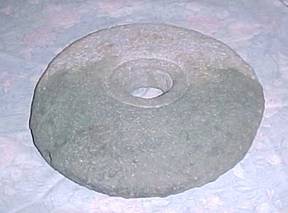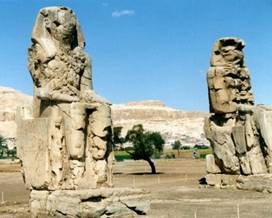Remarkable New Discoveries
|
|
It is really
great to be able to announce significant discoveries by members of our society and we have
had two in the last month. The first may have national importance but the second has
international importance.
Roman Quern
Stone
 Tim Macavoy brought his find along
to last month's meeting. It is a 44cm
diameter Roman grinding stone. The significant thing about it is that he found it in the
Douglas Valley, very near to the area we have been investigating regarding Roman mining
activity. Tim has had the stone confirmed as
Roman by none other than Dave Shotter from Lancaster University. Tim has also been busy filling out the finds
record card so that it can be properly recorded on the SMR. For various reasons he cannot
divulge the exact location of his find, not least because of the current countryside
restrictions. Before these came into force
Tim was able to carry out a quick check of the area immediately around the spot to see if
the find was in some sort of context or whether the other half was nearby. To both these
questions the answers were negative. Tim Macavoy brought his find along
to last month's meeting. It is a 44cm
diameter Roman grinding stone. The significant thing about it is that he found it in the
Douglas Valley, very near to the area we have been investigating regarding Roman mining
activity. Tim has had the stone confirmed as
Roman by none other than Dave Shotter from Lancaster University. Tim has also been busy filling out the finds
record card so that it can be properly recorded on the SMR. For various reasons he cannot
divulge the exact location of his find, not least because of the current countryside
restrictions. Before these came into force
Tim was able to carry out a quick check of the area immediately around the spot to see if
the find was in some sort of context or whether the other half was nearby. To both these
questions the answers were negative.
Last year,
Dave Thomas brought my attention to an extract from a book written in 1861 by the
government geologist Edward Hull, in which he specifically mentions Roman mining at Arley. The book, is called "The Coalfields of Great
Britain" and in it, Hull speaks of a "symmetrical arrangement and regularity of
workings peculiarly Roman". The
reference appears in a pre First World War booklet about the history of Standish Parish
Church. The quern stone find adds great
weight to the likelihood that Hull's report may well be true. You may recall our very
first Newsletter (No.1) reports on an article which appeared in The Antiquaries Journal
entitled "The Use of Coal in Roman Britain" cataloguing over 200 sites in
Britain where coal has been found in an archaeological context. Despite extensive research however the authors
were unable to identify a single site where Roman coal mining could be proven. This new find therefore perhaps could establish a
unique site in the British Isles and be a significant first for our society.
Henet-em-wiya

Our second
remarkable discovery concerns the small statues which appear at the feet of the Colossi of
Memnon, on the west bank of the Nile at Thebes. As
you probably know, Mike Booth and John Johnson (our resident Egyptologist), make regular
visits to Egypt taking pupils round the various sites and monuments. After their latest trip, Mike was showing off his
slides to John who noticed that the cartouche on one of the statues was not what he
expected to see. These famous statues,
which guard the road to the Valley of the Kings, belong to the 18th Dynasty Pharaoh,
Amenhotep III, who had a huge mortuary temple on this site.
The smaller statues at his feet represent his wife, Queen Tiy (appearing on both
monuments), his mother, Mut-em-wiya and one of his daughters, recorded as either Set-amun
or Henet-em-heb. This particular cartouche is
very faint and only visible at a certain time of day when the angle of the sun on the
surface is small. John is confident that
Mike's photograph in fact shows the name of Henet-em-wiya, a previously unknown daughter. If confirmed, this is a very significant discovery
as, although Amenhotep must have had a great number of daughters, the names of only a few
are actually known.
Next Meeting
Wednesday 4th
April at the BP Centre (Scout HQ) in Greenough Street, at 7.30 pm as usual. This month we have Chris Eldridge from Chester's
Military Museum who will be talking about Britain's involvement in Palestine in the First
World War. The troops, who were lucky enough
to be posted there instead of the western front, regarded the campaign as some sort of
modern day crusade. Chris, who is currently studying the subject at Cambridge University
has called is talk 'Knights in Kaki'.
Hope to
see you at the meeting -B.A
|



